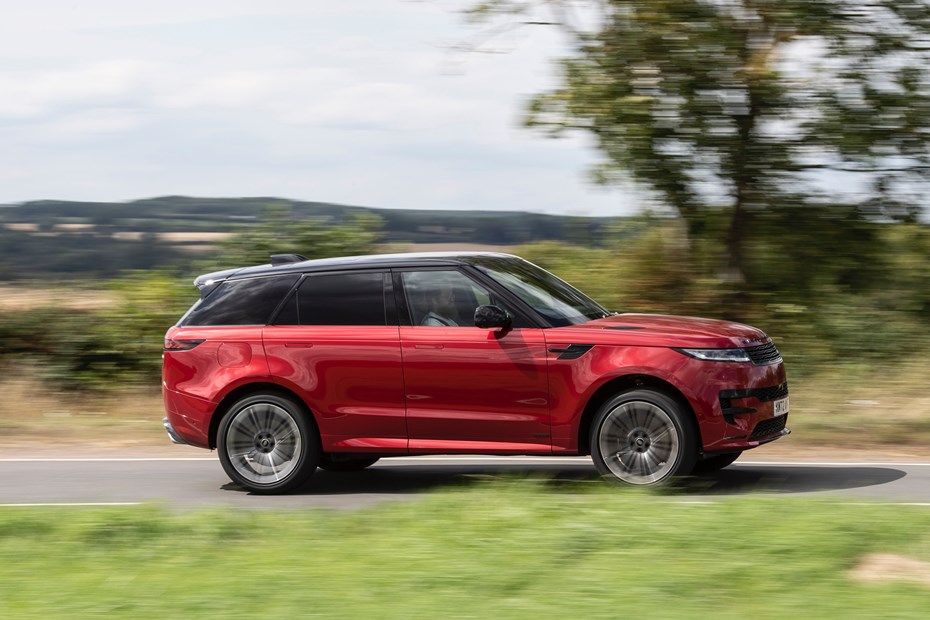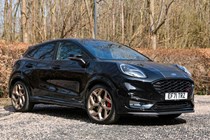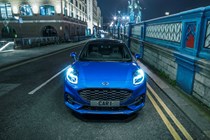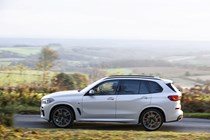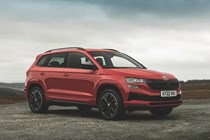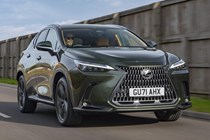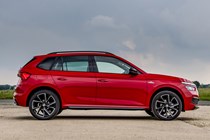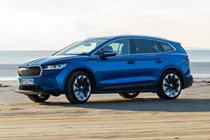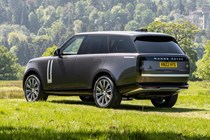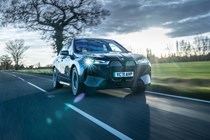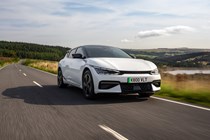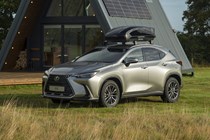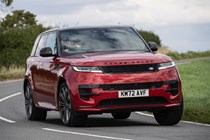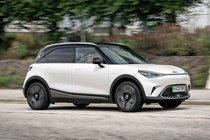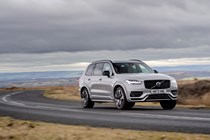It’s easy to see the appeal of the best SUVs. While they’ve evolved a long way from the working off-road and 4×4 vehicles of the past into the family-friendly lifestyle machines of today, by retaining high-riding practicality and an image of rugged capability they offer a do anything pragmatism that other types of car can’t match. No wonder SUVs have become the default choice for so many buyers.
With such popularity comes an almost overwhelming range of SUVs to choose from. But this is where we at Parkers are here to help. We’ve driven multiple versions of every example currently on sale in the UK, and on this page you’ll find our top 10 SUVs across the entire spectrum.
And SUVs do come in many different sizes. Yes, there are still big, gas-guzzling luxury SUVs, but even the real whoppers can be remarkably efficient these days. Meanwhile, at the other end of the scale, there are dozens of small SUVs, perfectly sized for single people, couples and modest families. Larger broods will be better served by proper family SUV models, or maybe even a seven-seater SUV if you need extra space.
Electric SUVs are increasingly popular, too. You’ll find our pick of the very best of all of these in this article. So read on to take your first step towards finding the perfect SUV for you.
Top 10 SUVs 2024
Brilliant small SUV that's great to drive and practical, too
The main boot is a useful size and there’s decent space inside the passenger compartment for four occupants. Interior quality could be better, but the dashboard is very user-friendly and stocked with all the latest essential technology. What's more, the Puma’s great to drive, feeling almost as playful as the Ford Fiesta that used to share the same underlying platform. The 1.0-litre EcoBoost mild-hybrid engine is a peach and very efficient, too.
To find out more read our full Ford Puma review
Pros
- Great to drive
- Economical mild-hybrid engines
- Ingenious Megabox boot
Cons
- Disappointing interior
- No plug-in or electric versions – yet
Kia EV6
Family-friendly crossover is one of the best electric cars available right now
Key to its appeal is that every model has a driving range of well over 300 miles. Charging times are fast, too. It’s also spacious, feels surprisingly athletic from behind the steering wheel, and it’s a quiet and comfortable cruiser. Just a shame the dashboard layout doesn’t entirely make sense.
To find out more read our full Kia EV6 review
Pros
- Long EV range
- Useful practicality
- Great to drive
Cons
- Not as high-riding as some SUVs
- Dashboard could be more user-friendly
Still one of the best seven-seat SUVs
As you’d expect of a Volvo, it’s very comfortable to travel in and the interior feels premium in a distinctively Swedish way. The screen-based dashboard controls won’t suit everyone, but the system is actually quite easy to use and doesn't require much of a learning curve. It’s surprisingly efficient for a big SUV, as well, but not as exciting to drive as other premium models - such as the BMW X5.
To find out more read our full Volvo XC90 review
Pros
- Genuine seven-adult space
- Big boot
- Comfortable
Cons
- Soon to be replaced
- Not exciting to drive
A cleverly thought-out family-size SUV
The dashboard is a masterclass in ergonomics and there are lots of Skoda’s Simply Clever features, including some ingenious storage compartments. The ride’s very comfortable, it handles neatly and the 150hp engines combine useful performance with strong fuel economy. Meanwhile, four-wheel-drive diesels have an impressively high towing capacity of 2100kg.
To find out more read our full Skoda Karoq review
Pros
- Super comfortable
- Rugged, no-nonsense interior
- Great visibility
Cons
- 1.0-litre engine sluggish on motorways
- No plug-in versions available
A luxury car that can climb a mountain
If off-roading is important, the Land Rover Defender is the ultimate choice, and the brand’s bestselling model – the chunky styling, lifestyle image and utility you get from the Defender clearly ticking the right boxes for many buyers. But for us, the extra layer of sophistication you get from the Sport would see it get our money.
To find out more read our full Range Rover Sport review
Pros
- Luxurious and good to drive
- Elegantly understated design
- Still unstoppable off-road
Cons
- Image won’t suit everyone
- Some build quality issues
Smart #1
The best small electric SUV
Especially when you consider the Smart comes loaded with standard kit. There’s a lot of interior space, too, though you will have to put up with a rather small boot, and some of the safety software is a little irritating. We’d take the #1 over the EX30 because the Volvo puts all its interior controls into a touchscreen. Prefer a sportier look? The Smart #3 is the same thing with a coupe roofline.
To find out more read our full Smart #1 review
Pros
- 270-mile driving range
- Strong performance
- Lots of standard kit
Cons
- Small boot
- Avoid the Brabus model
BMW iX
Get past the styling and this is a very fine electric SUV
As for the driving stats, xDrive40 models with the smaller 76.6kWh battery have a range of 249 miles on the WLTP cycle, while the xDrive50 can manage 380 miles on its 100kWh battery. The sheer size of the batteries means it can take a while to fully charge, but this is a small price to pay when everything else about the iX is so outstanding.
To find out more read our full BMW iX review
Pros
- Long range from big battery
- User-friendly tech
- Lots of passenger space
Cons
- Chintzy looks
- Small boot
Easy-to-live-with large SUV that happens to be electric
The Enyaq's practicality is underlined by offering space for five adults and a two-Labrador boot. The dashboard is another lesson in ease-of-use - though a lot of features you actually want are only on top trim levels or optional. The ride is smooth and quiet, and the handling is neat enough that the overall package gives very few reasons for complaint.
Read our full Skoda Enyaq iV review
Pros
- Spacious interior and big boot
- Lots of trim and equipment options
- 300-plus miles of range with big battery
Cons
- Not particularly brisk for an EV
- A lot of kit isn't standard
Lexus NX
Exquisite quality with excellent efficiency
Then there’s the interior, which looks fantastic and is exquisitely made from a palette of very high quality materials. Loads of tech, too, though some of the controls are a bit annoying. Space and practicality are perfectly adequate for a family car.
To find out more read our full Lexus NX review
Pros
- Comfortable and refined
- Fabulous build quality
- PHEV has good electric range
Cons
- Only average practicality
- Frustrating steering wheel controls
BMW X5
A full-size SUV that drives like a sports saloon
Let’s not forget the ludicrously fast X5M, either. Inside the X5, there’s generous space for five adults and a massive boot. It’s rather luxurious, too, and the infotainment system is packed full of tech. It’s controlled by the classic iDrive click wheel, via the touchscreen, or voice commands, or gesture. Only the Porsche Cayenne is better to drive, and that's not quite such a great all-rounder.
To find out more read our full BMW X5 review
Pros
- One of the best SUVs to drive
- Great EV range from PHEV
- Strong family car capability
Cons
- Big and unwieldy in town
- Divisive styling
FAQ: SUV questions answered
What does SUV stand for?
SUV stands for Sport Utility Vehicle. They come in many different sizes but they’re all linked by their high ride-height. The term SUV has been used for over 30 years. Originally coined in America, it was applied to four-wheel-drive cars with an emphasis on road-going comfort as well as off-roading ability. By contrast, many modern SUVs have no off-roading ability at all, indeed some are little more than tall hatchbacks and estates with the rugged look of a car that could go off-road. But that style is a big part of SUVs’ appeal to so many buyers.
Are all SUVs 4×4?
No. There was a time when pretty much every SUV had four-wheel-drive and could take you quite a long way into the wilderness. While there are still some SUVs that can do that – exemplified by the Land Rover Defender and Toyota Land Cruiser – that’s not really the point of these cars anymore.
If an SUV is fitted with four-wheel-drive – and many are – it’s there to improve traction on slippery roads and grip in corners. The vast majority of SUVs available to buy new at the moment are only two-wheel-drive.
Do SUVs flip easier than cars?
Not these days. Back in the 1980s, when the popularity of SUVs boomed, they earned a reputation for flipping over in emergency manoeuvres. Back then, though, SUVs tended to be top-heavy, had basic suspension, no electronic driver aids and very low handling limits. The safety of modern SUVs has taken a quantum leap forward.
Their suspension is much more sophisticated, they carry their weight lower down and they have an alphabet soup of acronymed stability aids to keep you on the straight and narrow. They do still have a relatively high centre of gravity which causes more body roll in corners, but something has to go drastically wrong to flip a modern SUV.
Is an SUV a good first car?
Absolutely. Small SUVs in particular are just as easy to drive as a hatchback of similar size. In fact, they’re arguably easier because their higher seating position gives better visibility – a key factor in the appeal of SUVs generally. Some brand-name driving schools have recognised the growing popularity of SUVs, as well. You’ll often see their instructors teaching learners in cars such as the Ford Puma.
Which is better: an SUV or MPV?
Also known as people carriers, MPVs were the car of choice for many families until the SUV took over in the late 2000s. You can read about the best MPVS on Parkers, but they’re now vastly outnumbered by SUVs. Which is better depends on your priorities.
If you need a car with maximum space for passengers and luggage, an MPV is still your best bet, van-based ones especially. There are plenty of SUVs with loads of space and big boots, but they ultimately can’t match the sheer volume and flexibility of an MPV’s interior. If, however, you need to tow or traverse rough roads, an SUV will be better for you.
What is a compact SUV/mini SUV?
Any SUV that’s less than about 4.2 metres long can be called a compact SUV, which makes them roughly the same size as a supermini hatchback. Indeed, many compact SUVs share their platforms with superminis. Popular ones include the Ford Puma and Renault Captur. There is some flexibility to that definition, though. Add in the word ‘premium’ or ‘luxury’ and the size boundary stretches up to about 4.5 metres.
What is a crossover?
It’s interesting how the language around SUVs is changing. For a brief period, the word ‘crossover’ was applied to SUVs that made no pretence of having off-road ability. We’re talking about cars such as the original Nissan Qashqai, Renault Kadjar and Lexus RX. But ‘crossover’ has already largely fallen out of favour. Most manufacturers now just use the term SUV, so that’s what we do at Parkers.
Why are SUVs so expensive?
It’s no secret that an SUV costs more than an equivalent hatchback, saloon or estate. For instance, an entry-level Ford Kuga costs around £6,000 more than the equivalent Focus. That’s partly because more material goes into building an SUV, but there’s also a premium to pay for the desirability of SUVs.
Higher prices mean SUVs are more profitable for car manufacturers, and many of them are refreshingly up front about that fact. For instance, Ford cited the greater profitability of the Puma compact SUV as one of the reasons it has stopped production of the Fiesta supermini.



